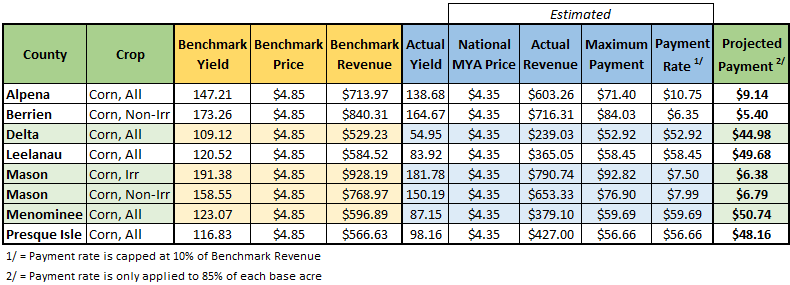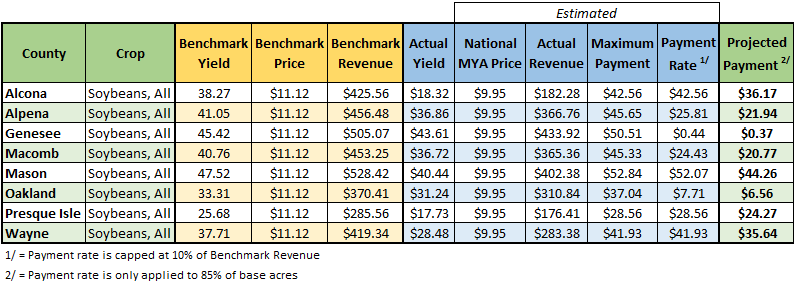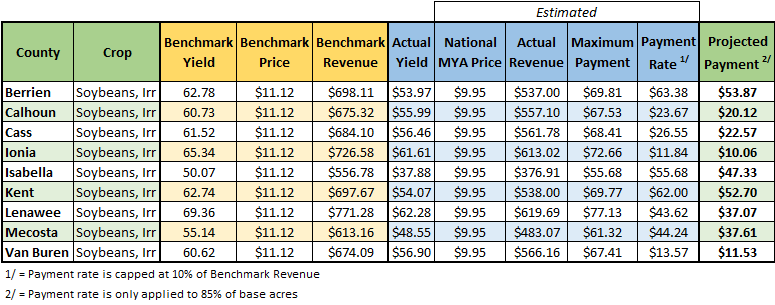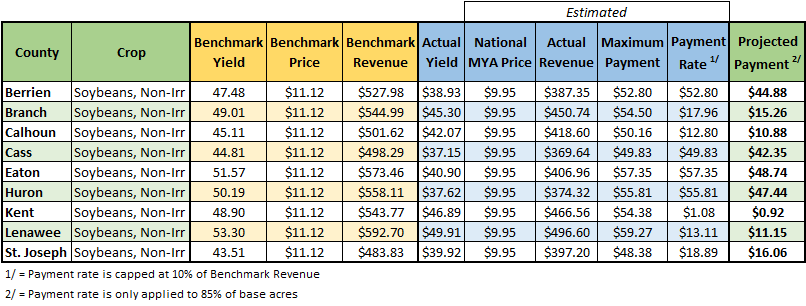Farm Bill Programs offer limited support for 2024 production year
New data emerges on support provided by current Farm Bill programs.

New data has emerged from the USDA on payment rates for both Price Loss Coverage (PLC) and Agriculture Risk Coverage (ARC-CO) programs. Estimated payments for corn, soybeans and wheat for 2024 are available, although market-year-average (MYA) pricing for corn and soybeans won’t be finalized until September. For Michigan field crop growers, there is no support expected from PLC and limited aid provided by ARC-CO. Depending on the crop, levels of support will vary in the ARC-CO program.
The lack of substantial support highlights why a number of reforms were included in recent legislation for both programs. But in order to better understand program adjustments, it’s important to recognize what factors influence payment rates.
Price Loss Coverage (PLC)
PLC payments are based on a market year average price (MYA). The market year begins at harvest and continues until the next harvest. For 2024 corn and soybean production, those months include September 2024 through August 2025, while wheat runs from June 2024 through May 2025. To trigger a payment, the market year average price must fall below a statutory reference price. The difference becomes PLC’s payment rate.
The 2024 reference prices were (per bushel)
- Corn: $4.26
- Soybeans: $9.66
- Wheat: $5.50
The final/estimated market-year-average (MYA) prices are
- Corn: $4.35 (Estimated)
- Soybeans: $9.95 (Estimated)
- Wheat: $5.52 (Final)
The final MYA price for wheat came in at $5.52, which is $0.02 above the $5.50 reference price. The estimated prices for corn and soybeans arrived similarly higher than their reference price counterparts. The MYA estimate of $4.35 for corn is $0.09 above the $4.26 reference price. The MYA estimate of $9.95 for soybeans is $0.29 above the $9.66 reference price. While there are still two months left in both crops’ marketing seasons, it is highly unlikely that the MYA prices will fall enough to generate a payment for either crop in PLC.
Adjustments to reference prices were the major change to the PLC program in recent legislation. For more information on how reference price adjustments may affect future payments, review MSU Extension’s article: Will higher reference prices yield higher PLC payments?
Agriculture Risk Coverage – County (ARC-CO)
Agriculture Risk Coverage has not faced as many calls for reform as PLC. The reason for that is likely because payments are based on county revenues. County revenues are calculated using a crop year’s market year average price multiplied by the county average yield. The emphasis on both price and yield is a key difference between ARC-CO and PLC, since ARC-CO offers more than one factor that can lead to support payments.
For payments to trigger, the actual county revenue must be less than the coverage guarantee. The coverage guarantee is 86% of the benchmark revenue, which is a five-year Olympic average of previous county revenues. Maximum payment rates are capped at 10% of the Benchmark Revenue. Payments are then paid on 85% of each base acre. Payments can be made on all acres or split between irrigated and non-irrigated if the county tracks separate yields for each.
The continual focus on revenue is an important component of determining support. In years when prices may be higher, yield losses can still trigger payments. Examples of yield impacts on payments can be seen in Figures 1-5. Note: all figures are estimated based on current data and do not indicate final payments.

Only seven counties in Michigan are estimated to receive ARC-CO payments for corn acres (Figure 1). Delta, Leelanau, Menominee and Presque Isle counties all had significant yield losses last year. Each of these four counties are expected to receive the maximum payment on enrolled base acres. The remaining three counties of Alpena, Berrien and Mason will also receive payments due to yield losses. The difference of $0.50 between the benchmark price ($4.85) and estimated MYA price ($4.35) would not generate a payment on its own because it also requires some sort of yield loss.. Mason will receive payments for both irrigated and non-irrigated acres.

The same scenario can be seen in wheat acres (Figure 2). Ottawa county should receive the maximum payment based on a yield loss of over ten bushels per acre. Ingham and Lapeer counties had minor yield losses but are also expected to receive payments. In all three counties, price losses alone would not generate a payment.
While very few counties are anticipated to receive ARC-CO payments for corn and wheat acres, soybean acres are expected to receive a little more support. Between designations of all, irrigated, and non-irrigated acres, 21 separate counties are estimated to receive soybean payments. Five counties should also receive payments on both irrigated and non-irrigated base acres. Figures 3-5 outline the breakdown of estimated soybean payments based on how yields are tracked.
Figure 3 outlines counties estimated to receive an ARC-CO payment for unirrigated and irrigated soybean acres tracked together or “all.”

Figure 4 outlines counties estimated to receive an ARC-CO payment for irrigated soybean acres.

Figure 5 outlines counties estimated to receive an ARC-CO payment for non-irrigated soybean acres.

Between Figures 3-5, payments are estimated to range from as much as $53.87 to $0.37 per base acre. The payment range accounts for the 85% adjustment per base acre. Counties listed all had some level of yield loss. Price was also a significant factor for soybeans which adds to the revenue support. With a benchmark price of $11.12 and an estimated MYA price of $9.95, there is a $1.17 per bushel difference. However, despite the difference, price alone would still not provide enough to generate payments on its own.
Note: Future ARC-CO payments will be based on a benchmark guarantee of 90% instead of the current 86%. Maximum payment rates will also be increased to 12% of the benchmark guarantee versus the current 10%. Current analysis remains unclear if changes to the ARC-CO program will affect how often payments are received.
Final payments for 2024 will be announced sometime in September after market-year-average (MYA) prices are finalized for corn and soybeans. The MYA price for wheat is finalized, but actual payment amounts should be confirmed with local USDA Farm Service Agency offices. Payment rates can also be seen via the ARC-CO Actual Payment Maps website, hosted by Kansas State University’s AgManager webpage.
For the latest on PLC and ARC-CO program information, visit USDA’s ARC/PLC Program Data website. MSU Extension will also be hosting several Farm Bill webinars as part of the Farm Policy & Risk Management Series. For the latest information on Farm Bill-relatedf programs, also visit the MSU Farm Bill website.



 Print
Print Email
Email